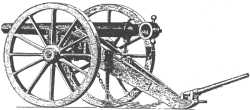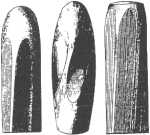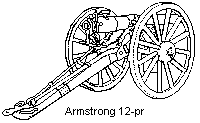The Gun - Rifled Ordnance: WhitworthIn December 1854 Armstrong approached the Secretary of State for War with a proposition that he make a rifled breech-loading (RBL) 3-pr gun for trial. Later bored up to 5-pr it performed with marked success both in range and accuracy. Over the next three years he went on to develop his system of construction and adapt it to guns of heavier calibre. We shall make a detailed study of one later in this paper. In the meantime in May 1854 the Board of Ordnance, not being entirely satisfied with the performance of the Pattern 1853 calibre .577-inch Enfield rifle, had engaged Joseph Whitworth, an eminent engineer, to try and improve it. Now Whitworth knew little about small arms or ordnance, so in 1855 conducted a series of experiments from which he deduced the twist of the rifling to be too slow for the length and weight of the bullet, causing it to become unstable at the longer ranges. To prove his point he constructed a rifle of .451-inch calibre with a bore of hexagonal section with rounded angles, firing a bullet shaped to fit. At a contest in 1857 between Enfield and Whitworth rifles the latter won by a significant margin. So impressed were the commander in Chief and the Master General of the Ordnance that they both urged him to try his hand at ordnance. To assist him they supplied several solid 'brass' castings of ML guns up to 24-pr for boring and rifling with his hexagonal system. Performances exceeded all expectations. For example, the range of a SBML 24-pr at 8° elevation was 2200 yards with the standard charge of 8lbs powder, while Whitworth's gun, firing a shot of the same weight at the same elevation, achieved a range of 3500 with only 2lbs. Indeed, so much did it exceed the anticipated range that the shot entered a house, narrowly missing a lady seated in her drawing room. What she said about Gunners I hesitate to record! Select committee decides on Armstrong's over Whitworth'sHe also rifled three cast iron 32-prs and a 68-pr supplied by the Government for trials with armour-piercing shot but all burst, which was not unexpected. Whitworth had already strongly advised against the use of cast iron for rifled guns. As well as carrying out experiments with Government-supplied guns he developed a 12-pr field gun using his own system of construction to be described below. Meanwhile the Select Committee appointed in August 1858 to recommend a system of rifled ordnance for adoption into the services was under pressure to make a quick decision owing to the current international situation. France, who had adopted rifled ordnance in 1856, was threatening to invade England.
Now the committee was impressed with Armstrong's guns with which they had become familiar but they had not studied Whitworth's; they had merely noted the performance of the Government guns he had rifled. Although they had promised to make a detailed study of Whitworth's system of gun construction they had not done so. Instead, in November 1858 they recommended Armstrong's system be adopted 'for special service in the field'.
To justify their failure to study Whitworth's system they made lame excuses, chief of which was that some of 'his' cast iron pieces had burst, when they well knew they were not 'his' but Government pieces. That he had advised the rifling of cast iron guns they chose to ignore. Also, they claimed his shot ranged differently from his shell - as they still do - and that his projectiles drifted - as they still do. Thus the committee hardly gave Whitworth a 'fair go'. Naturally he was rather upset. Determined to prove the superiority of his system he commenced making guns for sale to foreign powers, eg the Confederate States during the American Civil War. He later embarrassed the British authorities when his guns proved superior to Armstrong's in range, accuracy, and in the defeat of armour plate. Therefore, although Whitworth's guns were not accepted for the British forces, a brief description of their construction as well as ammunition will be given. The innovations they contained justify it. | |
Whitworth OrdnanceThe Whitworth gun was constructed on the 'built-up' principle, not by shrinking one tube over another but by forcing one over another by hydraulic pressure, which achieved the same result, ie the gun was 'pre-stressed'. The material used he called 'homogeneous iron', a form of mild steel. On the piece the breech was externally threaded and closed by a threaded cap which swung on a carrier pivoted on the right side of the gun. Firing was by friction tube inserted in an axial vent in the cap. Internally the piece was of hexagonal section (the angles of the hexagon being rounded) throughout its length, ie there was no chamber. The hexagon, made with a uniform twist, formed the rifling. |
 Whitworth RBL/RML 12-pr field gun. Calibre: 2.75-in.
|
|
The gun was designed to be used either as a breech-loader or as a muzzle-loader, possibly to satisfy diehard Officers, many of whom objected to breech-loading on principle. If used as a muzzle-loader the breech end was sealed by a copper disc with a central hole opposite the vent clamped in place by the breech cap. Tangent sights as used on other ML and RBL equipments were fitted. CarriagesCarriages resembled the current wooden field carriages for other service equipments. AmmuntionThere is little doubt Whitworth pioneered the system later called QF for when he used the gun as a breech-loader he enclosed the propellant charge in a sheet iron cartridge case shaped to fit the hexagonal bore, thus effectively providing obturation. After firing it was extracted with a special tool. If used as a muzzle-loader the charge was enclosed in a cloth bag as with other ML guns. Projectiles were precisely shaped to fit the bore with negligible windage; a wad in rear ensured complete sealing. Whitworth pioneered the use of streamlined shot and shell, and demonstrated the significant increase in range obtainable. | |
Whitworth ProjectilesAlthough Whitworth amply demonstrated the advantages of a streamlined projectile during the 1860s the idea was not taken up for another 60 or 70 years. Why this was so is hard to understand. In trials against armour he demonstrated that the shot shaped like a punch was the most effective for the purpose. The principle still holds good, but of course modern projectiles are fitted with ballistic caps to reduce air resistance. |
 Whitworth projectiles left: standard centre: streamlined right: armour piercing |
|
The calibre of Whitworth projectiles was measured across two opposite flats. The precision of their manufacture was probably the chief reason why his guns did not become popular. Projectiles were very accurately planned to shape, a more difficult process than turning, and fitted the bores extremely closely. Obviously neither bores nor projectiles were suited to mass production. Furthermore reports from America indicated bores had to be kept scrupulously clean at all times, not always possible on the battlefield, otherwise projectiles were inclined to jam. Whitworth's system applied to small arms worked very well as already shown. Some of his rifles found their way to New Zealand and examples may be seen in the Army Memorial Museum, Waiouru. Outwardly they closely resemble the Pattern 1853 Enfield. WL Ruffell, 1997 previous | index | next | History index | Home | |

